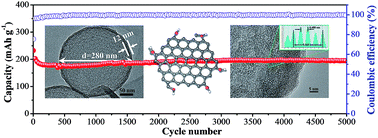Chemically activated hollow carbon nanospheres as a high-performance anode material for potassium ion batteries†
Abstract
Potassium-ion batteries (KIBs) are considered as a promising competitor to other metal-ion battery systems due to their low-cost and large-scale energy storage. However, their development is hindered by poor intercalation property of K ions in electrodes due to the heavier weight and larger size of K ion than those of Li ion. Therefore, achieving an ultra-long cycle life with high capacity and excellent rate capability remains a significant challenge for KIB electrodes. Herein, activated hollow carbon nanospheres (AHCSs), with enlarged interlayer spacing, oxygen-containing functional groups (OCFGs) on the surface and high specific surface area, are proposed as a new anode electrode for high-performance KIBs. Ex situ XRD and TEM results demonstrated that the enlarged interlayer spacing allow more reversible K ion intercalation into the carbon layer and readily accommodated large (de)potassiation strain without fracture, while OCFGs on AHCSs enhanced pseudocapacitance type behavior and specific capacity. Due to the synergistic effect of these structural features, the AHCSs served as anode for KIBs, exhibiting impressive electrochemical properties with high initial charge capacity of 370.2 mA h g−1 at 0.2 A g−1, ultra-long cycling life for 5000 cycles at a high current density of 2.0 A g−1, as well as prominent rate capability of 137.0 mA h g−1 at 4.0 A g−1. This study highlights the significant role of interlayer spacing, surface oxygen functionalization and hierarchical porosity of carbon-based anodes in potassium storage.

- This article is part of the themed collections: Materials and Nano Research in Atlanta and 2018 Journal of Materials Chemistry A HOT Papers


 Please wait while we load your content...
Please wait while we load your content...